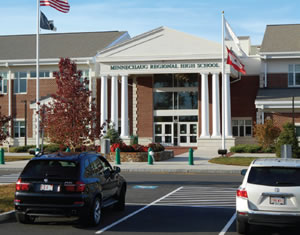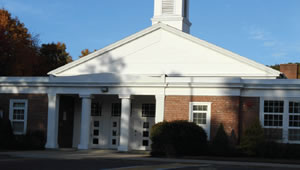Good Things Come in Small Packages
Hampden-Wilbraham Regional School District (HWRSD) in Wilbraham, Mass. doesn’t let size stand in the way of keeping its mechanical systems well maintained. Edward Cenedella, MCPPO, HWRSD’s director of Facilities and Operations, who has been with the district for 15 years, is responsible for all maintenance, construction, capital projects and custodial operations for the eightbuilding district totaling more than 700,000 square feet. He also currently serves as president of the Massachusetts Facilities Administrators Association (MFAA). Here, he tells how he and his team manage a successful maintenance program.

PHOTOS COURTESY OF HAMPDEN-WILBRAHAM REGIONAL SCHOOL DISTRICT
SP&M: What is HWRSD’s enrollment?
Cenedella: We serve 3,450 students in grades Pre-K through 12, in seven schools: one elementary and one middle in Hampden and three elementary, one middle and a regional high school in Wilbraham. Minnechaug, our flagship high school in Wilbraham, is brand new, having opened in August 2012. It houses 1,350 students in 148,000 square feet.
SP&M: What mechanical systems keep the new high school comfortable?
Cenedella: It’s a combination of HVAC systems. A portion of the building is supplied with a geothermal well serving chilled beams. On initial talks of building the school about seven years ago, the superintendent at the time was interested in having geothermal serve at least a portion of the facility. Also, the district had a swimming pool at the old high school and desired one at the new high school. However, the Massachusetts School Building Authority (MSBA) funds educational spaces, including gymnasiums and classrooms; they do not fund non-educational spaces, such as pools. So our two towns floated separate bonds to pay for the pool and an attached superintendent’s office, which MSBA funds also would not cover, and we chose the geothermal system for that portion of the building.
We also have a 450-ton chiller, rooftop air handlers and Direct Expansion (DX) units. The chiller serves administrative areas and an auditorium. The DX units serve smaller spaces. Our classrooms are not air conditioned.
SP&M: Does having this array of equipment cost more to maintain than is realized from energy savings?
Cenedella: The maintenance costs are much higher in the new school than they were in old high school, which did not have the efficiencies and the equipment we have now. However, I believe the energy savings we’re realizing offsets the design to save money in the long run.
SP&M: In this economy, do you have sufficient dollars and staff to maintain all that new equipment?
Cenedella: We have the dollars. We estimated maintenance costs in advance. From the building specs and the installed equipment lists, including the cooling tower and chiller, which we had never had, we made a list of what is required. Then we put an estimated maintenance cost on all of it. Plus, we received incentives from the gas and electric companies for specific things we did in the mechanical system design. So we knew what the energy use and energy costs were going to be, as extrapolated from the benefits they gave us. Additionally, because we budget a year ahead, we had a very good idea about what numbers we needed in certain line items for maintenance and operation.
Right now, we are a little short in personnel. For my FY15 budgeting, which begins in November, we’ll look at funding two new positions. The first is a grounds position, because the grounds are more extensive than before, with more parking spaces and more playing fields. And I’d like one more facilities person, such as an HVAC or electric professional.
Funding has been tough, but we’ve been able to change the way we do some things in order to gain savings. One savings on which we’ve gained tremendously is our energy contracts. I have a natural gas contract that goes from two years ago to the end of 2015. So, from historical energy use, we know our savings, which is what will allow us to fund more staff. Plus, we try to take advantage of utility-funded energy projects. For example, last winter, there was an offered project of re-lamping all our schools. We installed more than 10,0000 new 28-watt T8 lamps, which replaced 32-watt lamps. The energy consortium paid for the bulbs, and we have realized a net savings in electric use at all seven schools.
SP&M: What’s the age range and condition of the mechanical systems in the elementary and middle schools?
Cenedella: The oldest is a steam system installed in 1951. It has a new boiler and direct digital controls on it. Then there’s everything in between 1951 and 2012. Most of our buildings were built in the mid-to-late ‘60s, but the capital planning committees of both towns have been very aggressive in upgrading boilers and control systems. So, even though some of the schools are older, they are all direct digital control (DDC).

Scheduled Maintenance. The Hampden-Wilbraham Regional School District, in Massachusetts, has developed a set of maintenance procedures that helps them save money, keeps equipment functioning properly and keeps track of efficiencies, or the lack of them. This not only keeps the facilities comfortable, but also is helpful when budgeting for expenses, new equipment and even personnel.
SP&M: Why have the planning committees been so aggressive?
Cenedella: Because energy costs have skyrocketed since the late ‘70s, and our equipment efficiencies weren’t that good. Every few years, the committees funded changing the boiler and installing DDC in a specific school. We’ve also converted everything except the steam building to natural gas vs. fuel oil. The benefit is twofold. First, natural gas, even though it is a little more expensive, has been a bargain recently. Second, the maintenance of the equipment is less expensive, as it’s environmentally a cleaner fuel to burn.
SP&M: How does scheduling maintenance of the new systems differ from the old?
Cenedella: The new systems are much more complicated. In the past, we would have a location/equipment/schedule list and go out and PM those schools. Now there are so many other pieces of equipment, including LED lighting and new controls. In order to catalog the equipment, we were using a maintenance software program from SchoolDude called MaintenanceDirect, which is a work order system. Now we are using their PMDirect program, which allows us to generate PM schedules. It was populated from the information we had already entered into MaintenenceDirect and from all the manufacturers’ information we received as equipment was installed. Let’s say a piece of rooftop equipment needs something done every six months. PMDirect tells us the piece of equipment, its model and serial numbers, and what needs to be done. Plus it includes a reporting system that tells us if we keep repairing the same problem, which allows us to look into what’s going on with that piece of equipment. We really didn’t have that information before.
I’ve found that the software is pretty complete, and it supports our work quite well. I’ve added a staff person to manage it. This professional pulls work orders, distributes work orders, inputs information and pulls reports. This creates a system that’s accurate and reliable as far as the information it’s giving us.
SP&M: How do you assess that scheduled maintenance has occurred and occurred correctly?
Cenedella: When you have extensive reporting, it’s good information to work with because you now have a history. First of all, it has a budget piece with it so you can see how much you spent. Next, you should be able to catch problem areas and see the savings in the areas in which you’re spending money on repeat repairs. It gets you out of the “run to failure” mode and allows you to make repairs before problems become big and the costs become astronomical. It’s not a guarantee but it certainly helps you see good maintenance practices in your bottom line.
SP&M: Your district may be small, but it’s obvious there’s an overall commitment to mechanical system maintenance. How instrumental have you been in delivering that message?
Cenedella: I spent quite a bit of time with the previous business managers for our school committees and the public. During my tenure, three schools have been renovated, and I’ve been on the building committee for two of them. Plus, I was on the committee for the new high school. So the administration has come to realize that the opinion and perspective that facilities people provide regarding equipment is important.
This article originally appeared in the School Planning & Management November 2013 issue of Spaces4Learning.